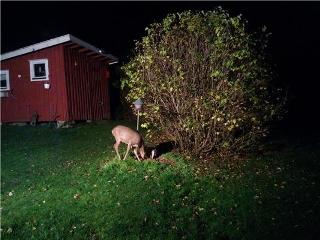Jul 17 2015
Urban wildlife such as deer, foxes and badgers should be cherished for the ecological benefits they bring to towns and cities, rather than feared as potentially harmful pests, scientists argue in a new report.
 Deer in garden
Deer in garden
The review, published in the scientific journal Wildlife Research, states that in order for humans and animals to live successfully side-by-side in built-up areas, a cultural shift is required for the public to fully appreciate the integral role that wildlife performs in urban ecosystems.
Much of the public dialogue about larger urban wildlife currently focuses on the risk of disease, pollution and threat to property or pets, rather than the positive contribution these animals can make.
Lead author Dr Carl Soulsbury, a conservation biologist based in the School of Life Sciences at the University of Lincoln, UK, said: “While promoting education about urban wildlife and its risks is important, the benefit wildlife brings to urban areas is often poorly communicated. It includes benefits such as regulating and supporting the ecosystem, through to improving human health and wellbeing.
“We need to identify ways to maximise the benefits, in particular increasing the accessibility of natural green spaces and promoting interactions with wildlife as a form of nature-based therapy. It is only through such an integrative approach that we can advance our understanding of how to live successfully alongside wildlife in an increasingly urbanised world.”
The researchers detail how urban wildlife can provide a range of benefits to human health and quality of life which are often undervalued or overlooked. For instance, there is a growing body of evidence that indicates the presence and viewing of urban wildlife is beneficial for human mental health and psychological wellbeing.
Urban animals also regulate and support the ecosystems of towns and cities. Many creatures serve as important predators of pest species – for example, songbirds help to control insect populations and predatory birds help rodent control.
But as urban human populations continue to grow, so too does the chance of ‘human-wildlife’ conflict, the researchers warn.
These conflicts occur when the activities of wildlife, whether through aggression, nuisance behaviour such as bin emptying or the spread of parasites or infectious diseases, have a negative effect on humans. Most such problems are minor, but can be distressing to individuals and tend to shape attitudes of the public and authorities.
Dr Soulsbury added: “The main problem is that many of the benefits of living alongside urban wildlife are difficult to quantify. However, we do know that the presence of wildlife gives people an opportunity to connect directly with nature at a local level. This is becoming particularly important in our increasingly urban society where humans are becoming more remote from the natural environment.
“More work is needed to better understand the role of urban wildlife and urban biodiversity in general, in the promotion of mental health and its greater role as a recreational and cultural ecosystem service. To do so wildlife biologists will need to work with other research disciplines including economics, public health, sociology, ethics, psychology and planning.”